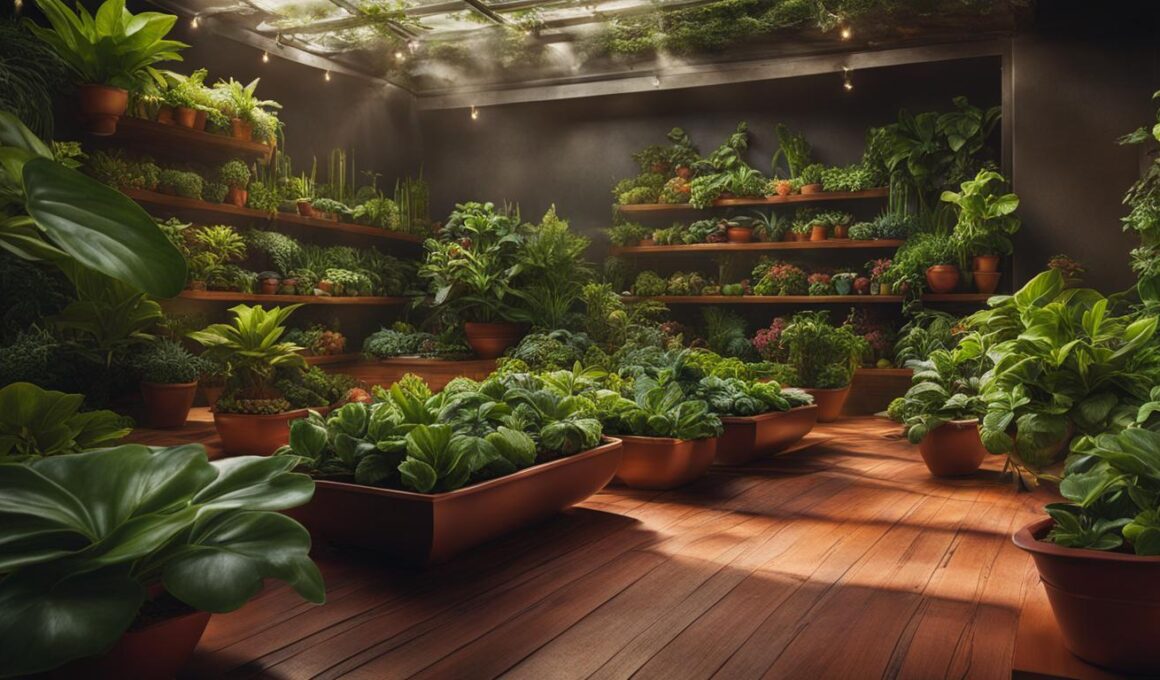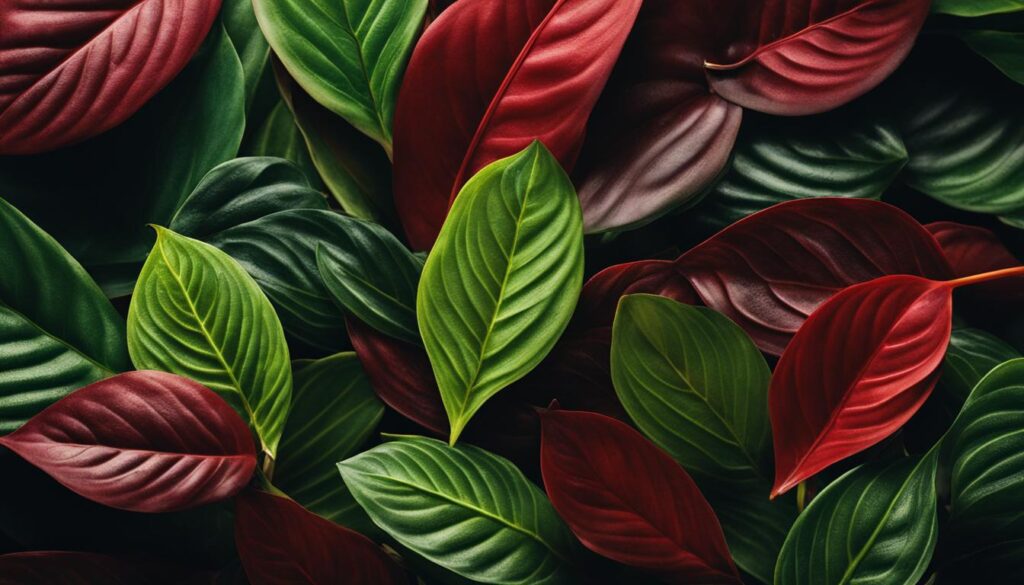Peperomia, one of the largest genera of the Piperaceae family, boasts over 1,000 species that make for versatile and attractive additions to any indoor garden. These houseplants excel in various lighting conditions and can adapt to water schedules, making them perfect for both experienced and beginner indoor gardeners. Known as radiator plants or baby rubber plants, peperomias add a stylish touch to your home with their unique, pet-friendly foliage. The Peperomia obtusifolia, or Baby Rubber Plant, enjoys immense popularity for its upright growth pattern and shiny, round leaves that can showcase variegation in yellow, white, and green.
Key Takeaways
- Peperomia encompasses over 1,000 diverse species that can thrive in various indoor environments.
- These low-maintenance houseplants adapt to a range of lighting conditions and water schedules, making them ideal for indoor gardeners.
- Known for their unique, pet-friendly foliage and adaptability, peperomias are also referred to as radiator plants or baby rubber plants.
- The Peperomia obtusifolia, or Baby Rubber Plant, is one of the most popular varieties, prized for its upright growth and shiny, round leaves.
- Peperomia varieties offer an abundance of leaf shapes, colors, and growth habits to suit your home décor and space requirements.
- Proper plant care ensures the health and well-being of your chosen Peperomia species.
- Propagation via leaf or stem cuttings allows enthusiasts to expand their Peperomia collection with ease.
Introduction to Peperomia Plants
Peperomia plants have been gaining popularity in indoor gardening due to their low-maintenance and pet-friendly nature. As a member of the pepper family, Peperomias encompass a wide variety of over 1,000 species, offering a rich diversity for houseplant enthusiasts. Their resilience and waxy leaf texture have earned them the nickname “radiator plants” or “baby rubber plants.” Regardless of your indoor environment, Peperomias can easily be integrated into your indoor garden thanks to their adaptability to different light and watering conditions.
The table below highlights some key benefits of incorporating Peperomia plants into your indoor garden:
| Benefit | Description |
|---|---|
| Low-Maintenance | Peperomias are generally easy to care for due to their tolerance for a variety of environmental conditions, such as indoor humidity and various lighting levels. |
| Pet-Friendly | Most Peperomia species are non-toxic to pets, making them ideal for households with furry family members. |
| Diversity | With over 1,000 species, Peperomias offer a wide range of leaf shapes, colors, and sizes, enhancing any indoor garden’s visual appeal. |
| Adaptability | Peperomias can thrive in a variety of lighting conditions, from bright, indirect light to low light, making them suitable for nearly any indoor space. |
Discovering this vast family of plants will unlock a world of houseplant care options that cater to your personal style and living environment. By understanding the distinctive traits of Peperomia plants, you can more easily choose the perfect varieties for your indoor garden.
The Versatile World of Peperomia Varieties
The diverse world of Peperomias boasts an incredible range of leaf structures and color spectrums, adding visual interest and variety to any indoor plant collection. In this section, we will explore the different leaf structures and the wide color spectrum found in Peperomia foliage.
Understanding the Different Leaf Structures
Peperomia leaf varieties showcase an impressive variety of structures, from small, patterned, succulent-like leaves to deeply ridged, heart-shaped leaves. Each species brings a unique aesthetic, making them a popular choice for those looking to enhance their indoor garden with captivating leaf structures.
- Peperomia prostrata (String of Turtles) – Features tiny, patterned, succulent-like leaves.
- Peperomia caperata (Ripple Peperomia) – Exhibits heart-shaped leaves with deep ridges.
- Peperomia argyreia (Watermelon Peperomia) – Boasts wide, teardrop-shaped leaves with a striking watermelon-like pattern.
The wide variety of leaf structures contributes to the plant morphology found in Peperomias, allowing enthusiasts to choose from rounded and bushy foliage to trailing vines with intricate patterns.
Color Spectrum of Peperomia Foliage
Another factor adding to the charm of Peperomia plants is their vast foliage color spectrum. From dark green hues to light silvery-green shades, these plants offer a palette suitable for any preference or interior design scheme.
- Silver Ripple Peperomia – Displays silvery-green leaves with small, dark green veins.
- Luna Red Peperomia – Presents a mix of purplish-red and silvery hues on its textured leaves.
Many Peperomia species also feature variegated foliage, further increasing their aesthetic diversity. For example, variegated Peperomia caperata and Peperomia orba exhibit white, cream, and yellow patterns against a green backdrop. These variegated peperomias create an eye-catching display that enhances the visual appeal of any indoor garden.
Caring for Your Peperomia Plants
Peperomia plant care is relatively simple, and these adaptable houseplants can thrive in diverse environments. In this section, we will discuss essential aspects of maintaining healthy Peperomia plants, including watering tips, light requirements, and soil preferences.
Watering Tips
Proper watering is crucial for houseplant maintenance. Here are a few pointers to keep your Peperomia hydrated and healthy:
- Allow the top few inches of soil to dry before watering.
- Water less frequently for succulent-like Peperomia varieties such as Peperomia asperula.
- Avoid over-watering, as this can lead to root rot.
Light Requirements
Peperomia plants generally prefer bright, indirect light. However, they can adapt to various light conditions, making them suitable for a range of indoor spaces. Keep the following in mind:
- Place your Peperomia near a window with filtered sunlight or in an area with bright, artificial light.
- Avoid direct sunlight, which can scorch the leaves.
- Some Peperomia varieties like the Ripple Peperomia can tolerate low light conditions.
Soil Preferences and Potting Mix
Peperomia plants prefer well-draining soil, which allows their roots to breathe and prevents root rot due to excessive moisture. Consider the following when choosing a potting mix for your Peperomia:
- Opt for a well-draining potting mix, usually containing peat moss, perlite, or coarse sand.
- Enhance the substrate with sand for better permeability, especially for Peperomia argyreia.
- For succulent-like varieties, choose a mix that retains less moisture.
Basic Peperomia Maintenance
Maintaining a thriving Peperomia collection entails some basic care routines:
| Task | Frequency | Remarks |
|---|---|---|
| Fertilizing | Every 2-3 months | Use a balanced liquid fertilizer diluted to half strength. |
| Pruning | As needed | Trim to maintain a compact shape and remove dead leaves. |
| Repotting | Every 2 years | Peperomia plants have a small root system and don’t require frequent repotting. |
By following these peperomia plant care guidelines, you are well on your way to nurturing a thriving, beautiful collection of Peperomia plants that enhance your indoor garden space.
Popular Peperomia Varieties for Your Home
With an abundance of versatile and captivating options, Peperomia varieties offer endless possibilities for your indoor plant collection. In this section, we will explore some of the most popular choices that are both easy to care for and add visually appealing elements to your home decor.
Identifying Growth Habits
Understanding the different plant growth patterns is essential in choosing the right Peperomia for your home. When examining growth habits, pay attention to the plant’s form, structure, and overall size. Peperomia varieties can be broadly categorized into two types based on their growth habits:
- Trailing Peperomia – These space-efficient houseplants cascade over surfaces or spill out from hanging planters. Examples include the Peperomia prostrata (String of Turtles) and the Peperomia rotundifolia (Trailing Jade).
- Upright Peperomia – These varieties stand vertically, making them perfect for tabletop displays or shelves. Examples include Peperomia obtusifolia (Baby Rubber Plant) and Peperomia polybotrya (Raindrop Peperomia).
Choosing the Right Variety for Your Space
When selecting the right Peperomia for your space, consider factors such as the available light, your preference for watering schedules, and the intended location for the plant. Begin your indoor plant selection by assessing the following characteristics of each variety:
- Space requirements: Opt for compact varieties like Peperomia orba (Peperomia Pixie Lime) if you have limited space. On the other hand, trailing varieties like Peperomia prostrata (String of Turtles) make excellent hanging plants.
- Light preferences: Consider the available light conditions in your home. Some Peperomia species, like Peperomia caperata (Ripple Peperomia), adapt well to low-light conditions, while others, such as Peperomia obtusifolia, thrive best in bright, indirect light.
- Foliage: The color and pattern of the foliage also play a significant role in choosing a decorative Peperomia. For instance, the Peperomia caperata ‘Variegata’ showcases eye-catching white, cream, and yellow patterns against a green backdrop.
By evaluating your available space, light conditions, and personal preferences, you can select Peperomia varieties that not only thrive in your home but also complement its existing interiors.
Propagation: Expanding Your Peperomia Collection
Propagating peperomia is an excellent way to expand your plant collection. This simple, easy-to-follow process offers an opportunity to clone your favorite varieties and create new plants for your home or to share with friends. In most cases, plant propagation can be achieved through leaf or stem cuttings.
- Leaf cuttings: To propagate peperomia using leaf cuttings, snip a healthy leaf with a small portion of the stem attached and place it in moist, well-draining potting mix. Keep the soil moist and place the cutting in a warm, bright spot with indirect light. In a few weeks, new roots and growth should start to appear.
- Stem cuttings: For peperomia cuttings that have a trailing habit, stem cuttings are an efficient method. Snip off a section of healthy stem with at least two leaves and remove the bottom leaf, leaving just a node at the base of the cutting. Place the node into water or moist potting mix, ensuring the remaining leaf stays above the water or soil line.
Once you have successfully propagated your peperomia, you can enjoy the benefits of expanding your plant collection. The table below lists a few popular Peperomia species suitable for propagation:
| Peperomia Species | Feature | Propagation Method |
|---|---|---|
| Peperomia Asperula | Folded, succulent-like leaves | Leaf cuttings |
| Peperomia Obtusifolia (Baby Rubber Plant) | Shiny, rounded leaves | Leaf cuttings |
| Peperomia Prostrata (String of Turtles) | Tiny, patterned leaves on trailing stems | Stem cuttings |
| Peperomia Caperata (Ripple Peperomia) | Deeply ridged, heart-shaped leaves | Leaf cuttings |
With these techniques for propagating peperomia, you can easily create new plants for yourself or share the joy of indoor gardening with others. This budget-friendly, creative process is an excellent way to enhance your love for these vibrant and diverse plants while watching your collection grow.
How Can Different Peperomia Varieties Enhance the Lushness of My Indoor Garden?
Watermelon peperomia care techniques can help enhance the lushness of your indoor garden. With their unique foliage and low maintenance needs, different peperomia varieties like watermelon peperomia can add texture and color to your indoor space. By providing proper care, you can enjoy thriving peperomias all year round.
Embracing Peperomia Diversity for Your Indoor Garden
In conclusion, this peperomia care guide presents a vibrant world of indoor plant diversity that can vastly enhance your home gardening endeavors. The various peperomia species offer a wide range of leaf structures, colors, and growth habits, making them versatile and decorative houseplants suitable for any indoor environment. With proper care, these attractive plants will thrive and add charm to your living space.
Selecting the right peperomia plant greatly depends on your aesthetic preferences and care requirements. From low-maintenance options like the Peperomia obtusifolia to unique trailing varieties such as the Peperomia prostrata, there is a peperomia plant to suit every gardener’s needs.
Now that you have a better understanding of the different peperomia varieties and their care needs, you’re equipped to foster a thriving indoor garden overflowing with lush, beautiful foliage. Embrace the captivating world of peperomia plants and elevate your home gardening experience to new heights.











